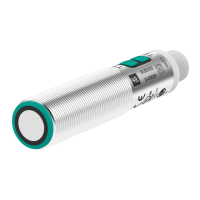2020-11
60
UC***-18GS series
Description of Sensor Parameters
8.5 Sensor Configuration – Synchronization
Synchronization Mode
In applications where multiple ultrasonic sensors are operated in close proximity to each other,
we must prevent these sensors from mutually influencing each other. Otherwise it can result in
individual devices providing incorrect measurements. The easiest way to solve this problem is
by synchronizing the devices.
You can set the type of synchronization by using the "Synchronization mode" parameter. The
following are the various synchronization modes in detail.
Automatic Multiplex Mode
This type of synchronization is essential for all applications in which each sensor has to individ-
ually determine its distance from the object.
The synchronized sensors self-synchronize in succession, i.e., there is always just one sensor
transmitting at any one time. The measuring cycles of the individual sensors run in succession
in a chronological sequence.
Advantage: mutual interference is completely avoided.
Disadvantage: delayed response time of the sensors by factor n. (n = number of the synchro-
nized sensors)
Automatic Common Mode
We recommend synchronizing in automatic common mode for all applications where there is
range monitoring, which is carried out using several sensors mounted in parallel. For example,
this could be a automatically-guided transport system which is implemented with several sen-
sors mounted in parallel. With these applications, it just has to be ensured that the automati-
cally-guided transport system does not collide with any obstacle. For the individual sensor, it is
irrelevant which sensor the sound of the received echo has been sent from.
The synchronized sensors work in a self-synchronized way at the same time, i.e., all sensors
always send their ultrasound pulse at the same time.
Advantage: response time of the individual sensors is as short as in stand-alone mode.
Disadvantage: mutual interference cannot be completely ruled out.
External Synchronization
External synchronization is only necessary if the number of sensors to be synchronized
exceeds the maximum specified in the datasheet. Or if the sensors need to be triggered in a
unique, application-specific sequence.
The synchronized sensors are triggered in parallel by an external square-wave signal (e.g., a
PLC output) and all sensors always send their ultrasound pulse at the same time.
Note
In addition to setting the "Synchronization mode" parameter, further measures are necessary
for synchronization to be successful. This could include connecting the devices to each other
accordingly. The commissioning instructions for the respective sensor provide details on this.
Parameter name Access Value range
Synchronization mode Read/write • Automatic multiplex mode
• Automatic common mode
• Externally controlled
Table 8.32

